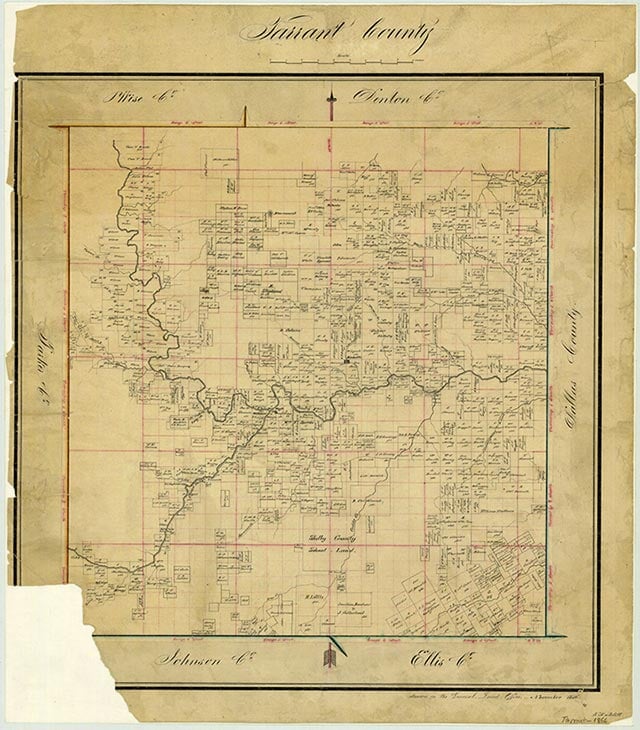Euless

Euless is at the intersection of State highways 10 and 183, on the southwest side of the Dallas-Fort Worth Airport, north of the West Fork of the Trinity River in Tarrant County. Bird's Fort was established at a site just south of the present city limits in 1841. The community began by 1845, when a small party of pioneers led by Isham Crowley reached the confluence of Big Bear and Little Bear creeks. There on the eastern edge of the site of present Euless, on the current airport grounds, a post office was founded in 1857, named Estill's Station, and a school, a church, a store, and a cotton gin were established. The post office closed in 1868. It reopened, 1881–1904, under the name Estelle. Most of the community gradually dissipated and moved to present Euless and Irving. A mile or more to the southwest, around 1876, a community hall-church-school building was erected. In 1881 Elisha Adam and Julia Euless from Tennessee built a home and cotton gin nearby, and the community began to thrive. Local farmers decided to honor the young man whose presence seemed to coincide with better times, and the community was named for him. The Euless post office opened in 1886 and closed in 1910. Euless farmers usually journeyed to Dallas to buy supplies and sell produce and cotton. In 1903 the Rock Island Railroad built a depot two miles south of Euless at Candon, whose name changed to Tarrant by 1905. Tarrant had a post office, 1905–23, and in the 1910s Tarrant may have had 100 people and Euless twenty-five. The Rock Island soon discontinued regular service, and the depot closed in the 1930s. By then Euless may have attained a population of 100, while Tarrant's was perhaps twenty-five. Tarrant gradually merged with Euless. From the early twentieth century to the mid-1930s Euless community life revolved around the general store run by the Fuller family, the Baptist and Methodist churches, and the Euless School, erected in 1913. The Tennessee Dairies receiving plant in Euless and the Fort Worth Sand and Gravel Company just south of town in the Trinity bottoms opened operations in the 1920s, aiding a number of local farm families in supplementing meager farm incomes. The brewing and sale of illegal whiskey during prohibition, 1919–33, was another economic stimulus in the area. Electricity arrived in 1929, and the school achieved high school status in 1934. After the stimulus of World War II there were perhaps 300 people in Euless and Tarrant by the end of the 1940s. The Euless post office reopened in 1949. A crisis moved the community to the edge of violence. In 1949 Black parents in Mosier Valley refused to obey new orders from the Euless school superintendent, which called for the busing of their children outside their district to Fort Worth (see EDUCATION FOR AFRICAN AMERICANS). There were closer schools in Euless, but they had always been for Whites only. The Mosier Valley elementary school was a tattered branch of the Euless district. A district judge ruled that Texas law provided that students had a right to be educated in their own districts and that a district's schools were supposed to be funded impartially. Texas at the time had some 1,100 districts that bused Blacks to other districts, and it appeared for some months as though segregation in Texas might stand or fall on the Euless case. Blacks entered the Euless school on September 4, 1950, in an attempt at enrollment, and the building was soon surrounded by a hostile crowd of some 150 Whites. The school superintendent informed his Black audience in the auditorium that he had to enforce the state's segregation laws. Blacks returned to the Mosier Valley school, which was quickly refurbished by White authorities. The village incorporated in 1951, disincorporated in 1952 over water and sewer taxes, and reincorporated in 1953. The Euless school district merged with Hurst in 1955 and was joined by Bedford in 1958. The HEB district desegregated in 1968. Growth was enhanced in the early 1950s by the paving of old State Highway 183 and Farm Road 157 and the construction of Amon Carter (Air) Field (see AMR CORPORATION) on the eastern edge of Euless, which opened in 1953. The Euless Chamber of Commerce was established in 1952 and merged with that of Hurst in 1955. The Menasco Manufacturing Company, which made airplane parts, was an important local manufacturer. American Airlines began moving its installations to Euless in 1957. The population surged to over 4,200 in 1960. In 1967 Euless voted 211 to 133 to merge with smaller Bedford, but an overwhelming majority in Bedford opposed it. Hurst, Euless, and Bedford all approved the establishment of a joint hospital district in 1969. Euless's population climbed to 19,300 in 1970, but the completion of Airport Freeway and the Dallas-Fort Worth Airport drove land prices out of reach for most of the decade. The population increased only to 24,000 in 1980. The town is heavily committed to arboreal beautification, reflected dramatically in its annual Arbor Daze fair launched in 1989. The DFW Airport's announcement to expand a new west side runway in 1988 triggered an acrimonious conflict with Euless and a prolonged legal tussle. The town could lose $100,000,000 worth of property. Euless had a population of over 38,000 in 1990.
George N. Green | © TSHA

Adapted from the official Handbook of Texas, a state encyclopedia developed by Texas State Historical Association (TSHA). It is an authoritative source of trusted historical records.

- ✅ Adoption Status:
- This place is available for adoption! Available for adoption!
- Adopted by:
- Your name goes here
- Dedication Message:
- Your message goes here
Belongs to
Euless is part of or belongs to the following places:
Currently Exists
Yes
Place type
Euless is classified as a Town
Associated Names
- (Estelle)
Location
Latitude: 32.85086100Longitude: -97.07979100
Has Post Office
Yes
Is Incorporated
Yes
Population Count, 2021 View more »
60,500
